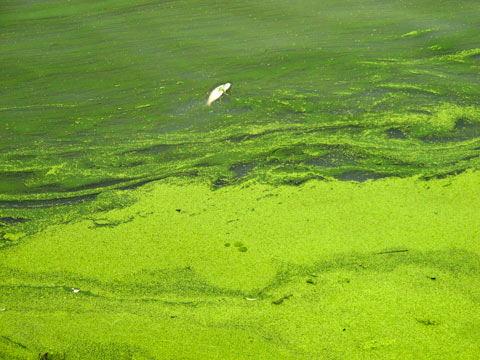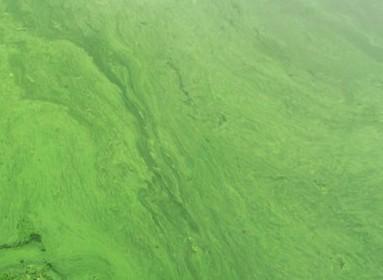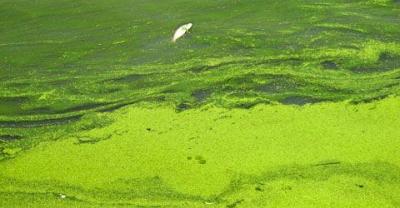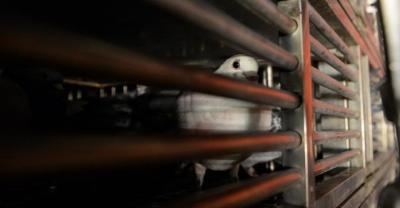How harmful is the outbreak season of cyanobacteria to aquaculture?
Cyanobacteria, also known as slime algae, is the simplest and most primitive single-celled organism. Cyanobacteria are widely distributed in natural water bodies and have caused serious harm to aquaculture. How to control the harm of cyanobacteria is an urgent matter for the aquaculture industry.
1. Analysis of plant characteristics of cyanobacteria
It is well known that the occurrence of cyanobacteria depends largely on temperature. Cyanobacteria are sensitive to temperature when they breed. When the water temperature is below 17 ℃, they will not be produced in large quantities, or will not cause harm to fish. When the water temperature rises to 28 ℃, cyanobacteria can easily form the dominant population and break out in large numbers due to the inhibition of the growth of other algae and the ingestion and metabolism of fish with high temperature.
For aquaculture areas, the main reasons for the formation of cyanobacteria are suitable environmental conditions, unreasonable fish stocking and uneven fertilization. Because cyanobacteria mostly occur from June to September in summer, there is obvious seasonality. Temperature, light, nutrients and climatic conditions are all factors affecting its growth. Under the conditions of suitable water temperature (above 20 ℃), eutrophication, higher pH value, suitable light intensity and light time, cyanobacteria form air bags and float to the surface of the water body, and the population propagates rapidly, so that cyanobacteria blooms form on the surface of the water. In the fish ponds with high fertilizer application and domestic sewage discharge, the water is rich in nutrients, which can promote the proliferation of blue-green algae such as Anabaena, Microcystis aeruginosa, spirulina, fibrillaria and so on. if the number of silver carp and tilapia that can feed on these algae is relatively small, so that a large number of phytoplankton can not be utilized and die naturally in the water. Generally speaking, the amount of fertilizer applied in the early stage is too high, phytoplankton multiply in large numbers, and the late lack of fertilizer or topdressing is not in time, and the phytoplankton cells wither and die. These dead phytoplankton float on the water surface, thus forming water blooms.
II. Summary of the harm of cyanobacteria to aquaculture
Cyanobacteria is characterized by crazy growth, from this point on the harm to aquaculture is difficult to digest, resulting in water eutrophication. Fish do not like to eat cyanobacteria, the algae are difficult to digest and the utilization rate is low. For example, if a large number of algae are mixed in the intestines of fish in the water Washington period, microscopic examination of the contents in the front, middle and rear intestines shows that the algae masses are intact and not easy to digest. A large number of indigestible algae exist, resulting in eutrophication of the water body. At the same time, cyanobacteria bloom caused a sharp decrease in biodiversity, the mass reproduction of cyanobacteria worsened the ventilation and light conditions of pond water, inhibited the growth and reproduction of beneficial species of plankton in fish ponds, and hindered the photosynthesis of algae. Squeeze out the living space of digestible algae in fish, so that filamentous algae and planktonic algae in fish ponds can not synthesize their own nutrients and die. In addition, the mass reproduction of cyanobacteria leads to anoxia, deterioration of water quality, mass reproduction of cyanobacteria and decomposition of dead algae, which consumes a lot of dissolved oxygen, which can lead to anoxia or even anoxia in water. At the same time, it is also easy to lead to flooding in aquaculture water. Cyanobacteria are easy to damage water quality when a large number of cyanobacteria die, and can produce toxic substances such as phycotoxin, hydroxylamine and hydrogen sulfide, which are directly harmful to aquatic animals. The dead cyanobacteria release a large amount of organic matter, which stimulates the growth of heterotrophic bacteria, some of which also bring pathogenic bacteria to fish, leading to secondary infection of bacterial diseases. When cyanobacteria multiply in large numbers, it gives off a fishy smell, which affects the normal function of the water body. Environmental degradation causes the death of aquatic animals. During the occurrence of cyanobacteria bloom, the physical and chemical indexes of the water body often exceed the tolerance limit of aquatic animals, resulting in death.

The amount of dissolved oxygen in the water decreased during the outbreak of cyanobacteria, and the fish died from hypoxia.
The common cyanobacteria in aquaculture water can be divided into two types: one is filamentous cyanobacteria, including tremor, Anabaena and spirulina, and the other is unicellular algae, such as microcystis. Among them, the algae aggregates formed by the accumulation of a large number of microcysts on the surface of the water body are the most common cyanobacteria blooms in aquaculture. Therefore, microcystins are one of the most common types of microcystins. Microcystins are a group of monocyclic heptapeptides, in which there are two variable amino acids. So far, 80 different subtypes of microcystins have been found according to the degree of methylation, hydroxylation, episomerization and variable amino acids. Because of its liver, kidney and other organ toxicity and strong cancer promotion, microcystins have been considered as a serious threat to wild animals and plants and human health. Thus it can be seen that cyanobacteria have obvious biological harm to aquatic animals both in vivo and in remnant. Third, discussion on the prevention and control measures of cyanobacteria harming aquaculture.
In view of the different spread of cyanobacteria, we can prescribe the right medicine, for example, when the cyanobacteria has not covered the surface of the water, but only a small part of the growth, manual salvage is the first choice. Manual salvage not only costs a certain amount of manpower, but also is the safest for the water composition of the whole aquaculture area. When cyanobacteria are gradually spreading and manual salvage has been unable to stop the expansion of cyanobacteria, we can try to consider the growth environment of cyanobacteria itself. without harming the growth of aquatic products, Bacillus subtilis is the best. Bacillus subtilis is the best, static water and water flow rate < 4cm/S, which is suitable for cyanobacteria growth. > 10cm/S inhibited the growth of cyanobacteria. During shrimp culture, a water wheel aerator can be used to increase the flow rate; high temperature, water temperature > 28 ℃ is suitable for cyanobacteria growth, while < 17 ℃ inhibits cyanobacteria growth, so it is a better time to deal with cyanobacteria before overcast and rainy weather; high pH, water pH > 8.4 HCO3-accounts for up to 95% of inorganic carbon, while CO2 is less than 3%. Cyanobacteria can use CO2 and HCO3- to grow, while other beneficial algae can only use CO2, so high pH is beneficial to the growth of cyanobacteria. In production, lactic acid bacteria or EM or organic acids can be applied to reduce the overall or local pH of water to inhibit the growth of cyanobacteria. In addition, the breeding of silver carp and the use of the food chain can also control the reproduction of algae from the source. Chemical killing is not recommended as a last resort, which will bring a lot of toxins to the aquaculture water.

A serious outbreak of cyanobacteria water
To sum up, the harm of cyanobacteria is very terrible, but it is not untreatable. The control of cyanobacteria should be based on the principle of prevention and curb the initial growth of cyanobacteria at the source, which is the healthiest and wisest choice for aquaculture areas.
- Prev

For poultry farming, let's also talk about the tricks for taking care of the eggs.
The significance of the egg in the whole hatching process is very great. If the egg is accurate, it can greatly improve the effective utilization of the hatching equipment. Even if you order an egg, you have to talk about it.
- Next

Have you ever been to Guangxi to investigate the breeding of bamboo rats?
These days, an old friend who raised bamboo rats in Hunan, why is he an old friend? he began to contact me in 16 years and called me.
Related
- On the eggshell is a badge full of pride. British Poultry Egg Market and Consumer observation
- British study: 72% of Britons are willing to buy native eggs raised by insects
- Guidelines for friendly egg production revised the increase of space in chicken sheds can not be forced to change feathers and lay eggs.
- Risk of delay in customs clearance Australia suspends lobster exports to China
- Pig semen-the Vector of virus Transmission (4)
- Pig semen-the Vector of virus Transmission (3)
- Five common causes of difficult control of classical swine fever in clinic and their countermeasures
- Foot-and-mouth disease is the most effective way to prevent it!
- PED is the number one killer of piglets and has to be guarded against in autumn and winter.
- What is "yellow fat pig"? Have you ever heard the pig collector talk about "yellow fat pig"?

